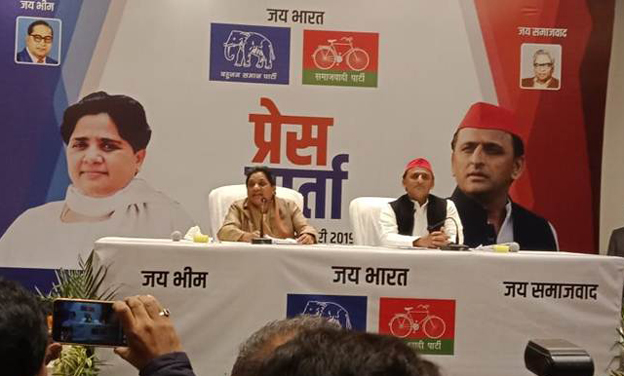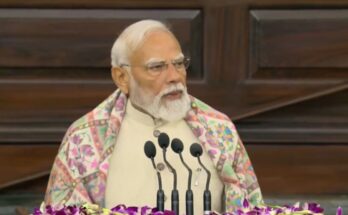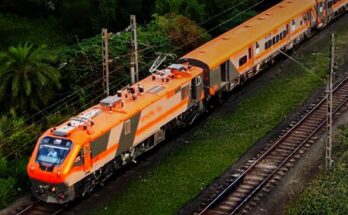By Priya Ranjan Sahu
At the peak of the movement for Ram Temple in Ayodhya around 25 years ago, Samajwadi Party leader Mulayam Singh Yadav and Bahujan Samaj Party leader Kansi Ram joined hands to halt the Bharatiya Janata Party on its track. They were successful in the sense that the SP-BSP combine formed the government in Uttar Pradesh with help from smaller parties despite the BJP emerging as the single largest party after 1993 assembly elections.
History repeated itself on Saturday as Mulayam Singh Yadav’s son Akhilesh Singh Yadav and Kansi Ram’s protégé Mayawati again joined hands to defeat the BJP in the upcoming Lok Sabha elections. As per a deal struck between both the former Uttar Pradesh chief ministers, the SP and BSP will contest 38 Lok Sabha seats leaving two seats for other friendly political parties. They have also kept another two seats – Amethi and Rae Bareli – open for Congress president Rahul Gandhi and former president Sonia Gandhi.
Out of the total 547 Lok Sabha seats in Parliament, Uttar Pradesh accounts for the largest number of 80 seats. The sheer numerical strength of Uttar Pradesh has led to the popular belief that the road to Delhi is through its capital Lucknow.
In 2014, while the BJP won 282 Lok Sabha seats across the country, around a third of it, 71 seats, came from Uttar Pradesh. Prime Minister Narendra Modi also won from Baranasi Lok Sabha constituency. The BJP maintained its grip over the state in the assembly elections in the state in 2017 when it won 312 seats out of the total 403.
The SP and BSP, two other major political forces fought both the Lok Sabha and assembly elections separately, and lost miserably. In the general elections, while SP won five Lok Sabha seats, the BSP drew a blank. Likewise, in the assembly elections SP, which had an alliance with the Congress, won 47 seats while the BSP got 19 seats.
Though the achievement of the BJP looked spectacular on both the occasions, deeper analysis of the poll results reveal that the national party just took advantage of fragmentation of votes in a three-cornered contest with the Congress being relegated to a distant fourth position.
The vote percentages of the BJP, SP and BSP in 2014 were 42.30, 20.20 and 19.60 respectively. But in 2017, though the BJP swept the assembly polls, it got 39.7 per cent while SP and BSP got 22 per cent each.
All these poll arithmetic have brought the SP and BSP together. As the first experiments, the SP-BSP’s combined force convincingly defeated the BJP in the bye elections for Gorakhpur, Phulpur and Kairana Lok Sabha elections last year. Especially, losing Gorakhpur, which Adityanath represented five times before becoming chief minister, and Phulpur, which deputy chief minister Keshav Prasad Maurya won with a huge margin in 2014, was a rude shock to the BJP.
Now the official announcement of a coalition by Akhilesh Singh Yadav and Mayawati spells trouble for the BJP. The national party that looked invincible has suddenly become vulnerable not only in Uttar Pradesh but also nationally.
The leaders in the BJP know very well that it is difficult to come back to power in Delhi unless they retain a majority of Lok Sabha seats won in Uttar Pradesh in 2014. They also know that it is all the more difficult to do it in the face of a combined force of SP-BSP considering the caste equations in the state.
Even in 2014, had the two regional parties fought the elections jointly, the BJP’s tally might have been around a half of what it got and the course of politics at the national level been different. Poll data show that the combined votes of the SP and BSP were more than that of the BJP in at least 41 seats.
Around five years later, the BJP and its mascot Modi have lost much of their political shine. On the other hand, a resurgent Congress has added to the BJP’s woes.
The SP and BSP have left the Congress out of their coalition. In her joint press conference with Akhilesh Yadav, Mayawati said that they did not take the Congress along because in the past the latter had benefited from an alliance but “its votes did not transferred to us”.
For the laymen, it may sound like the SP-BJP ditching the Congress. But the fact of the matter is that the vote bases of both BJP and Congress are the same and in the event of the Congress joining SP-BJP, there is a danger of the former’s upper caste votes transferring to the BJP.
Strategically, the Congress fighting the elections separately in Uttar Pradesh is beneficial to the SP-BSP combine and bad news for the BJP.




